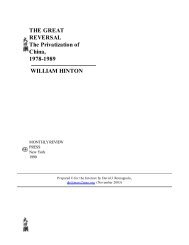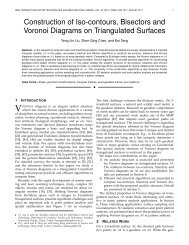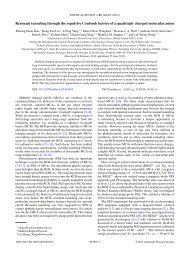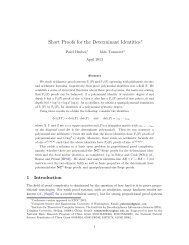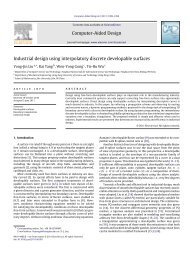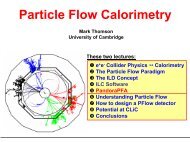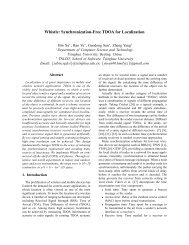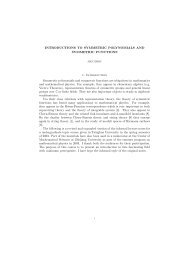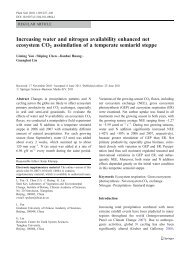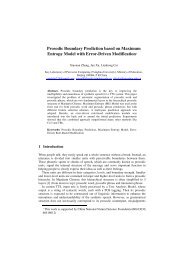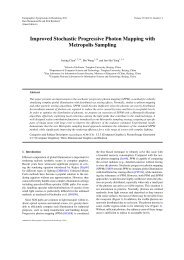Feature Preserving Mesh Simplification Using Feature Sensitive Metric
Feature Preserving Mesh Simplification Using Feature Sensitive Metric
Feature Preserving Mesh Simplification Using Feature Sensitive Metric
You also want an ePaper? Increase the reach of your titles
YUMPU automatically turns print PDFs into web optimized ePapers that Google loves.
600 J. Comput. Sci. & Technol., May 2010, Vol.25, No.3<br />
on creases and corners. It means that vertices in feature<br />
regions in FS space have tiny difference only at the<br />
coefficients related to normal direction. When a vertex<br />
on sharp feature is decomposed into several new points<br />
in FS space, features will get flatter than their preimage<br />
in R 3 , so that contraction error in blow-up regions will<br />
be extremely small. This indicates that sharp features<br />
which have been blown will get top priority in the error<br />
heap. To avoid this, the number of blow-up vertex<br />
have to be constrained. We have found out that most<br />
feature vertices can at most be decomposed into two<br />
or three 6D points, and the improvement under this<br />
strategy could be ignored. This may lose the advantages<br />
of both the error metric in FS space and blow-up<br />
phenomenon.<br />
For this reason, a specific rule that simulates the effect<br />
of blow-up scheme is designed. The basic idea is<br />
to change the contraction cost function into a weighted<br />
quadric error rather than veritably expands the features<br />
into several blow-up points which are identical<br />
in R 3 . The weighted quadric error is then defined as:<br />
ξ<br />
k ′ = η kξ k where η denotes the number of vertices that<br />
the current vertex will be expanded to. We firstly<br />
launch a shrink-back procedure during initialization to<br />
ensure there is no degenerated edge in R 3 . The blow-up<br />
weight is then directly inherited from the blow-up rule<br />
in [8] as follows.<br />
1) If a vertex v is neither labeled as edge nor corner<br />
vertex, we simply set η i = 1.<br />
2) If v lies on the edge which the angle deviation<br />
θ of normal vector on either side of the edge is larger<br />
than a threshold value θ E (we use π/4 for all models in<br />
this paper), this vertex is treated as edge vertex. The<br />
corresponding weight is assigned as:<br />
η i =<br />
⌈ θ<br />
θ t<br />
⌉<br />
+ 1 (9)<br />
According to the above rules, Ση i is obvious with<br />
the same amount of vertices at the blow-up region in FS<br />
space. So this rule will not lose the significance of blowup<br />
phenomenon. To ensure that contraction point is a<br />
local minimum under FS error metric, blow-up weights<br />
should not be taken into account in the optimization.<br />
In other words, η only influences the priority of the<br />
elements in error heap.<br />
The rule for updating error cost of contraction point<br />
¯v is also improved. For a vertex pair with at most one<br />
blow-up vertex, new weight is set to be the average of<br />
η i , η j , so that new error cost equivalent to the general<br />
cases. For a pair containing two vertices that the corresponding<br />
weights are all greater than 1, new weight<br />
for target point is updated to η i + η j , so that error cost<br />
actually becomes (η j + η j )(ξ i + ξ j ), meaning that when<br />
an edge containing two feature vertices is contracted,<br />
the optimized contraction position is an abstraction of<br />
the current feature region, so it should be more difficult<br />
to simplify.<br />
Although this procedure extract feature naively, we<br />
found this strategy gives further improvement to FS<br />
metric based method. Results in Fig.2 demonstrates<br />
the effectiveness of this method.<br />
4.2 <strong>Preserving</strong> and Post Cleaning<br />
Open boundaries require additional constraint during<br />
the optimization process. For a contraction containing<br />
boundary points v b , linear search for optimization<br />
point is constrained in the plane that is spanned by<br />
two boundary edges intersecting at v b . For simplicity,<br />
we search the optimized boundary point along the<br />
boundary line which consists of v bleft , v b and v bright .<br />
We test face-flipping after target point optimization. In<br />
case that flipping occurred, we use a penalty multiple to<br />
where “⌈·⌉” denotes the ceil operation, θ t is an userspecified<br />
step factor means the mesh density in blow-up<br />
region.<br />
3) If there are at least three sharp edges meeting at<br />
a vertex, this vertex is treated as a corner. Moreover,<br />
a cone-like vertex is also labeled as corner if the sum of<br />
the angle of one-ring neighboring triangles is less than<br />
2π cos θ C , where θ C is the corner threshold, we use π/12<br />
in this paper. Blow-up weight for corners is then defined<br />
as:<br />
η i = ∑ η k + 1 (10)<br />
where η k is the weight of the k-th neighbor vertex of<br />
the corner v. For simplicity, we do not allow the existence<br />
of the two adjacent corners. Once it occurs, we<br />
use a dummy point between them and simply set it as<br />
an edge point.<br />
Fig.7. Edge-flipping to remove near-degenerated triangles. (a)<br />
Before edge-flipping. (b) After edge-flipping. The amount of<br />
faces is not changed after the flipping process.



